By Dr. Thomas Burnell and Bethany Turner
Questions by Dr. Peter Parkinson
Next Lesson - Congenital Heart Defects
Abstract
- The heart begins as two endocardial tubes which fuse into one heart tube in the thoracic region of the embryo during folding.
- The atria and ventricles are formed by separation of the primitive atrium and ventricle respectively. The endocardial cushions play a central role in both processes.
- Fetal circulation uses hunts to bypasses the liver via the ductus arteriosus and the lungs via the foramen ovale and ductus arteriosus.
- The outflow tract of the heart spirals to form the aorta and pulmonary trunk, and the vessels branching from the aorta are formed from the aortic arches.
Core
The cardiovascular system begins development at around the the 10th day after fertilisation. The heart is the first functional organ to develop, with the heart beat able to be heard on sonography by around the 6th week.
Formation of the Primitive Heart Tube
At the start of its development, the cardiovascular system exists as two regions near the cranial end of the embryo. These regions are called cardiogenic fields and they are derived from the mesoderm layer of the embryo. The cells that will go on to form the cardiovascular system reside here.
The cardiogenic fields consist of blood islands which are primitive tissues, and mark the beginning of blood, vessel and heart development. These areas develop further and fuse to form two tubes, which are called endocardial tubes, one on each side of the embryo.
In the fourth week of development the embryo begins to fold, which will put the heart tissue in the correct position to form the primitive heart tube surrounded by the pericardial sac. The embryo folds in two directions:
- Cephalo-caudal folding brings the cardiogenic fields from the cranial end towards the centre of the embryo to sit in thoracic region where the heart will be.
- Lateral folding fuses the two lateral sides of the embryo. This brings to two cardiogenic fields into the midline so they can fuse and form the primitive heart tube.
This primitive heart tube is formed at around day 25 of gestation. It is divided into six parts:
- Aortic roots
- Form the arteries of the aortic arch
- Truncus arteriosus
- Involved in the formation of the pulmonary trunk and aorta (outflow from the heart)
- Bulbus cordis
- Involved in the formation of the pulmonary trunk and aorta (outflow from the heart)
- Primitive ventricle
- Forms the ventricles
- Primitive atrium
- Forms the atria
- Sinus venosus
- Forms part of the right atrium and vena cava
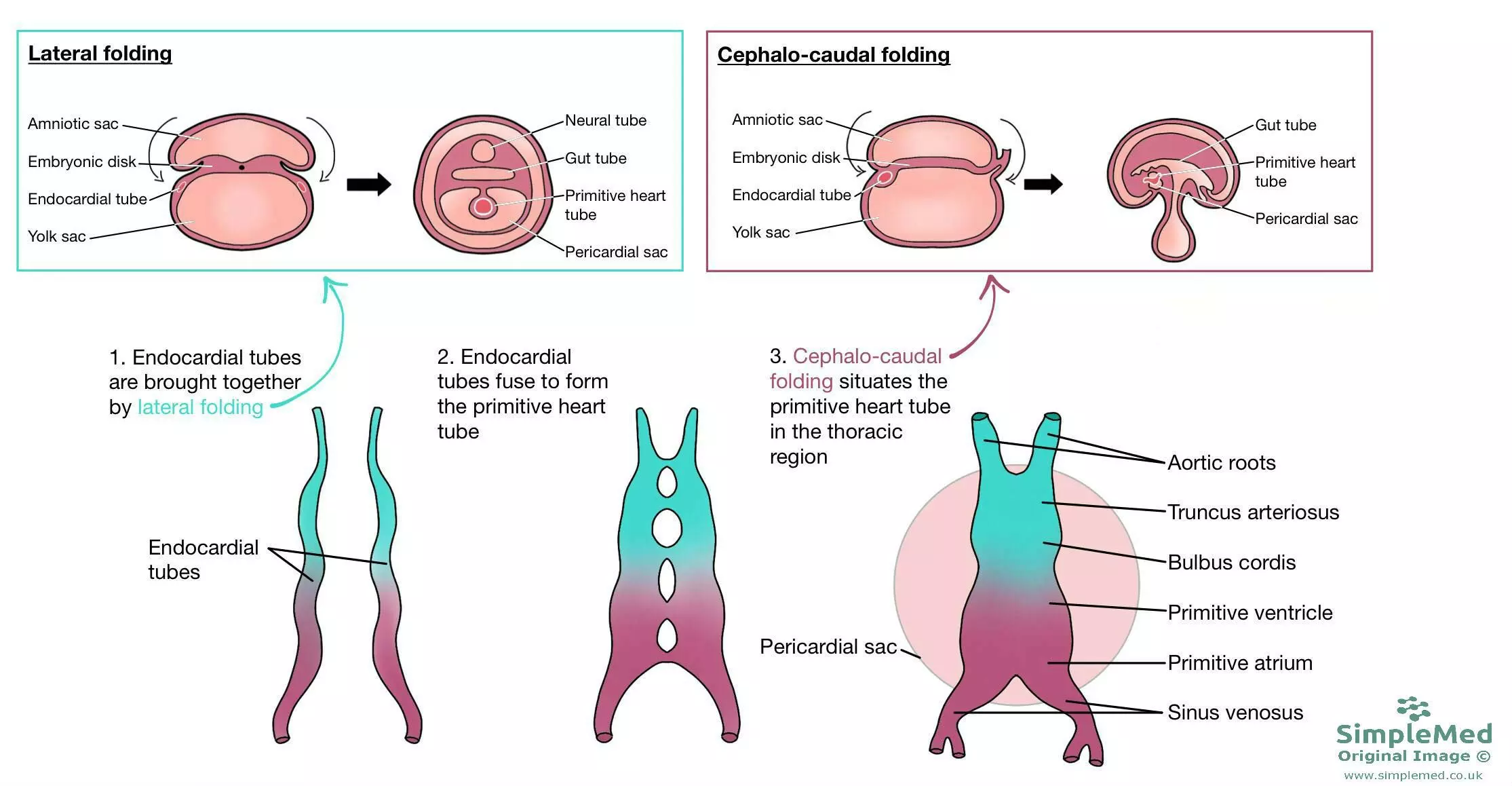
Diagram - Shows how the embryo folds, and endocardial tubes fuse to form the primitive heart tube in the pericardial cavity. The heart tube sits in the thoracic region of the embryo
SimpleMed original by Bethany Turner
The newly formed heart tube is surrounded by the pericardial sac. As the heart tube grows and elongates, it gets too long for the sac.
This means that to fit, it must loop. The primitive ventricle moves ventrally and to the right, while the primitive atrium moves dorsally and to the left. This puts the inflow portion of the heart (veins and atria) behind the outflow portion (ventricles and arteries) – the same shape and orientation as mature hearts.
This looping creates a space behind the arteries (aorta and pulmonary trunk) and in front of the superior vena cava, called the transverse pericardial sinus.

Diagram - The looping of the heart tube in the pericardial cavity. When folding is finished, the primitive ventricle is sitting at the bottom of the cavity, with the primitive atrium behind it
SimpleMed original by Bethany Turner
Development of the Right Atrium
The right atrium develops from most of the primitive atrium, and part of the sinus venosus.
The sinus venosus receives blood from the right and left sinus horns, bringing blood into the primitive heart tube. The right sinus horn is partially absorbed by the primitive atrium as it grows. This forms the superior and inferior vena cava. The left sinus horn becomes the coronary sinus which drains venous blood from the coronary vessels into the right atrium.
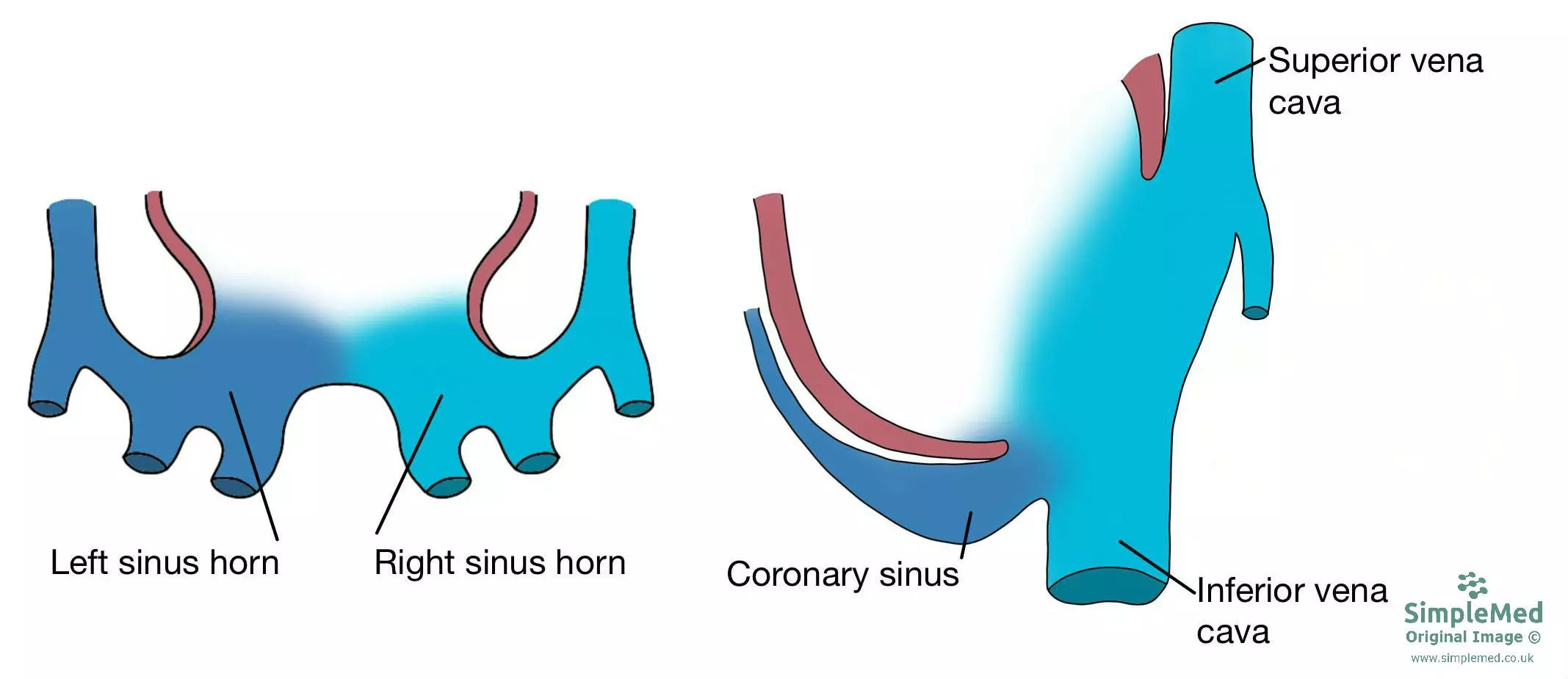
Diagram - The blue represents the sinus venosus. The light blue portion represents the right sinus horn which becomes absorbed by the right atrium to become the superior and inferior vena cava. The dark blue portion represents the left sinus horn which becomes the coronary sinus
SimpleMed original by Bethany Turner
Development of the Left Atrium
The left atrium develops from a small part of the primitive atrium, and the proximal portions of the pulmonary veins.
The pulmonary veins begin as a single vein entering the left atrium. This vein is formed from four branches which converge to form one vein draining into the developing left atrium. As the left atrium grows, it absorbs the single pulmonary vein, absorbing all the way to the four branches. This means that when the left atrium has finished growing, it is receiving blood from four pulmonary veins, as seen in mature hearts.
The part of the mature left atrium that came from the primitive atrium is trabeculated. This forms the left auricle in the mature heart, which is a little pouch in the wall of the left atrium. The part derived from the pulmonary veins (which makes up most of the future right atrium) is smooth. The auricle is an important feature of the mature heart because with atrial fibrillation (a condition where the atria do not contract efficiently) blood can collect here. This stasis can go on to cause blood clots, which can travel to the brain causing stroke or other organs causing infarction.
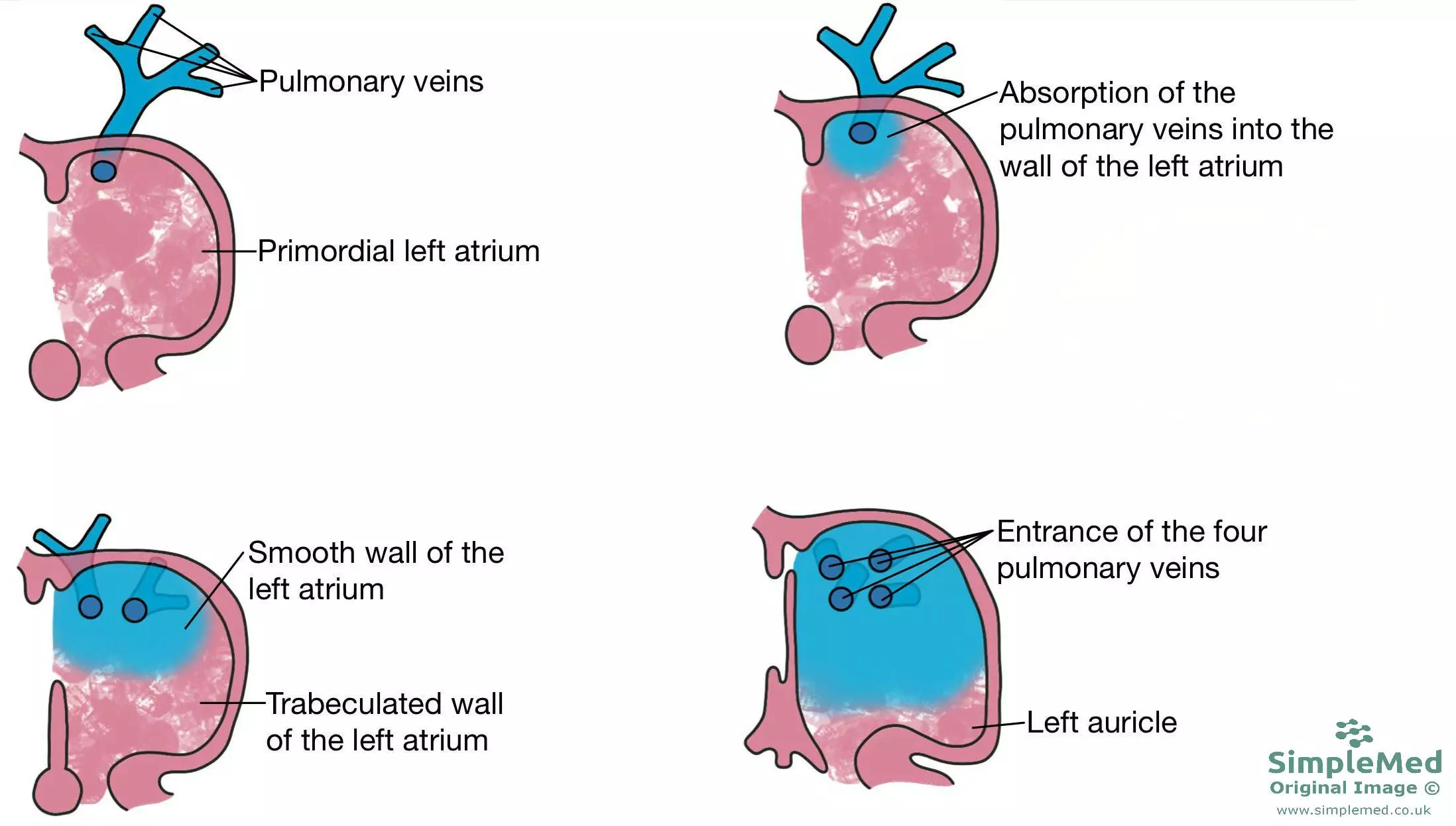
Diagram - The proximal parts of the pulmonary veins become absorbed into the wall of the left atrium. The contribution of the pulmonary veins is shown in blue, and the primitive left atrium is shown in pink
SimpleMed original by Bethany Turner
The lining of the dorsal and ventral aspects of the developing heart grow small bumps called endocardial cushions. These grow to meet in the middle of the heart and are key in the separation of the left and right sides of the heart. They act almost as a target for the septa that develop as each septum will grow towards the cushions.
The atrial septum is formed from two septa which grow in a specific order:
- A septum of tissue grows down from the top of the developing atria towards the endocardial cushions. This is the septum primum, and as it grows down, the communicating hole between the atria is called the ostium primum.
- Just before the septum primum meets the endocardial cushions and the ostium primum is closed, a hole forms in the middle of the septum. This is the ostium secundum.
- The septum primum meets the endocardial cushions, and the ostium secundum allows blood to continue to move from the right atrium to the left.
- Another septum grows down from the top of the atria, called the septum secundum.
- As the septum secundum grows down, it leaves another hole just below the ostium secundum.
These two septa, and two holes together form the foramen ovale - a right to left shunt allowing blood to flow from the right atrium into the left. This shunt will reverse and close after birth, as discussed later. The ostium secundum and foramen ovale are staggered in their orientation and this is key in allowing for shunt closure.
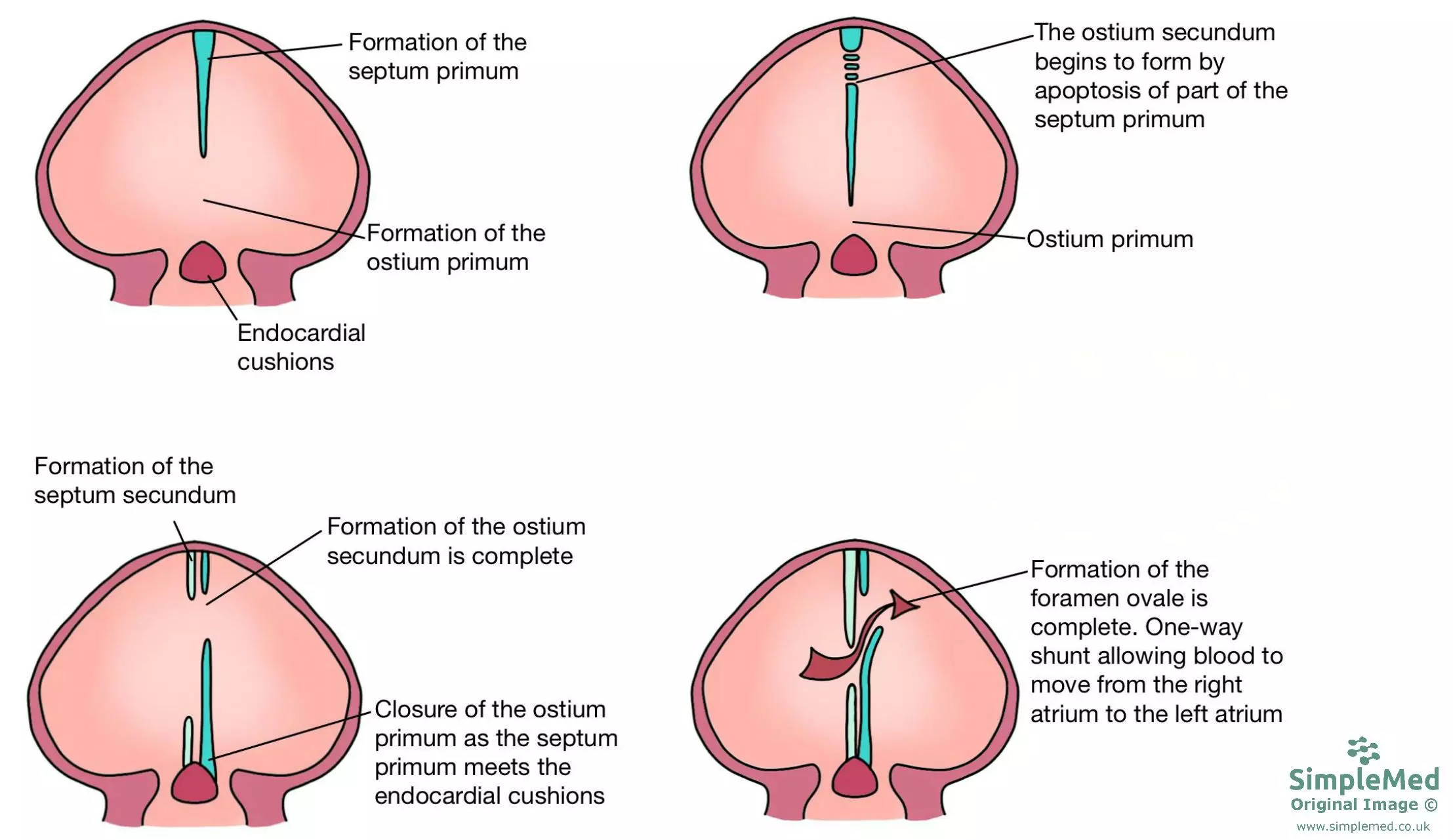
Diagram - The formation of the septum. Also shown is the expansion of the atria by the contributions of the veins
SimpleMed original by Bethany Turner
The formation of the ventricular septum take place in two steps.
First, a muscular portion of heart tissue grows upwards from the floor of the primitive ventricle towards the endocardial cushions. It doesn’t quite reach the cushions, forming the primary interventricular foramen.
A membranous portion then grows down from the endocardial cushions to meet the membranous portion and close the foramen. A defect in the formation of the membranous portion is a common reason for ventricular septal defects, as discussed in the Congenital Heart Defects article.
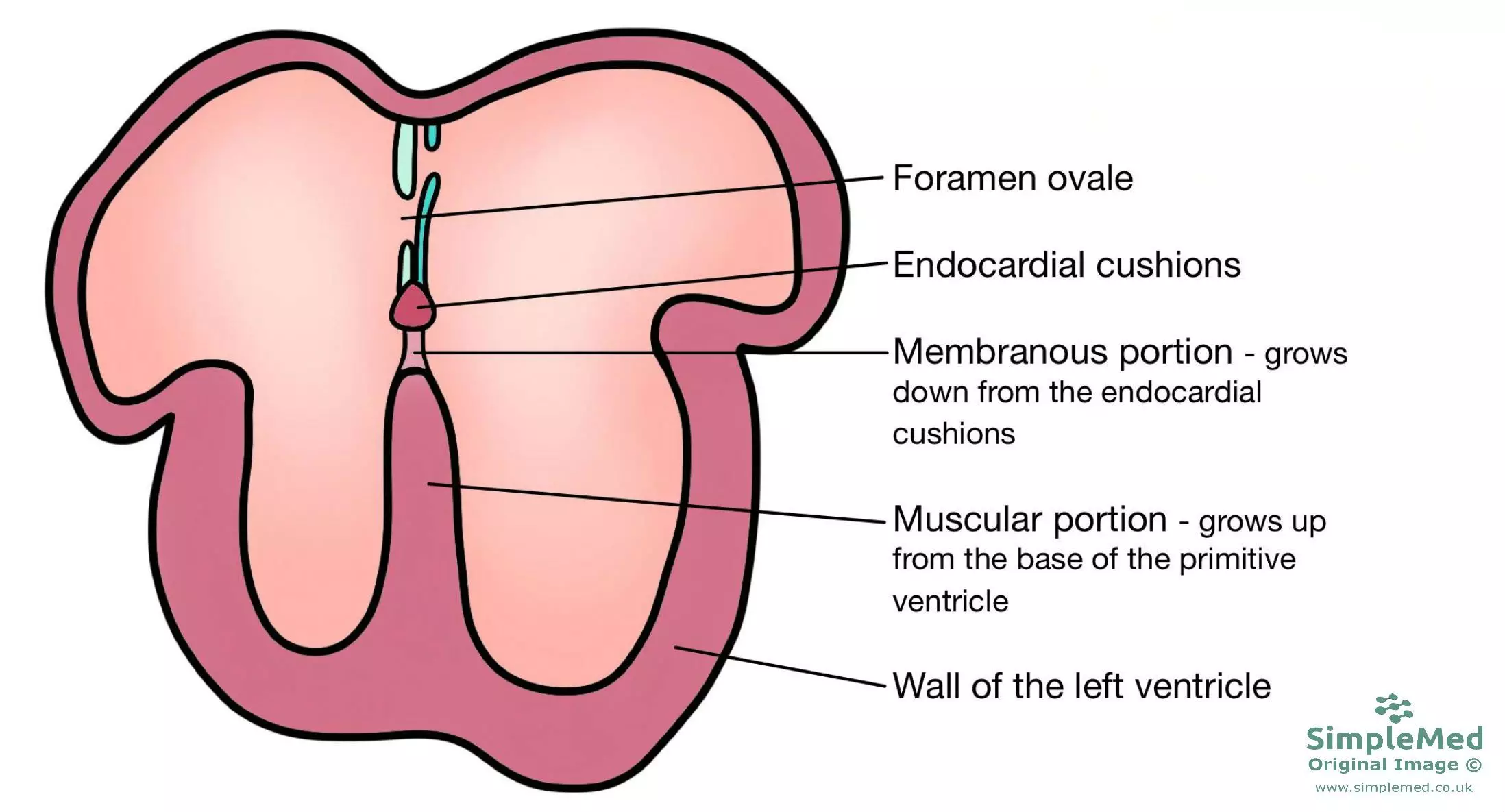
Diagram - The formation of the interventricular septum. The muscular portion grows upwards from the base of the ventricles. The membranous portion grows down from the endocardial cushions to the muscular portion. Also shown in the diagram is the septum separating the ventricles
SimpleMed original by Bethany Turner
Septation of the Outflow Tract
The bulbus cordis and truncus arteriosus form one tube allowing outflow from the heart. This tube needs to be spilt in order to form the aorta and pulmonary trunk.
In the beginning of this process, there are two lines of proliferations of neural crest cells (these cells appear in the neural tube during neurulation and migrate to contribute to the development of a wide range of structures) on the walls of the outflow tract.
These two lines of cells spiral around and grow towards each other to meet in the middle. This form a single spiral septum called the aorticopulmonary septum – consequently forming the aorta and pulmonary trunk.
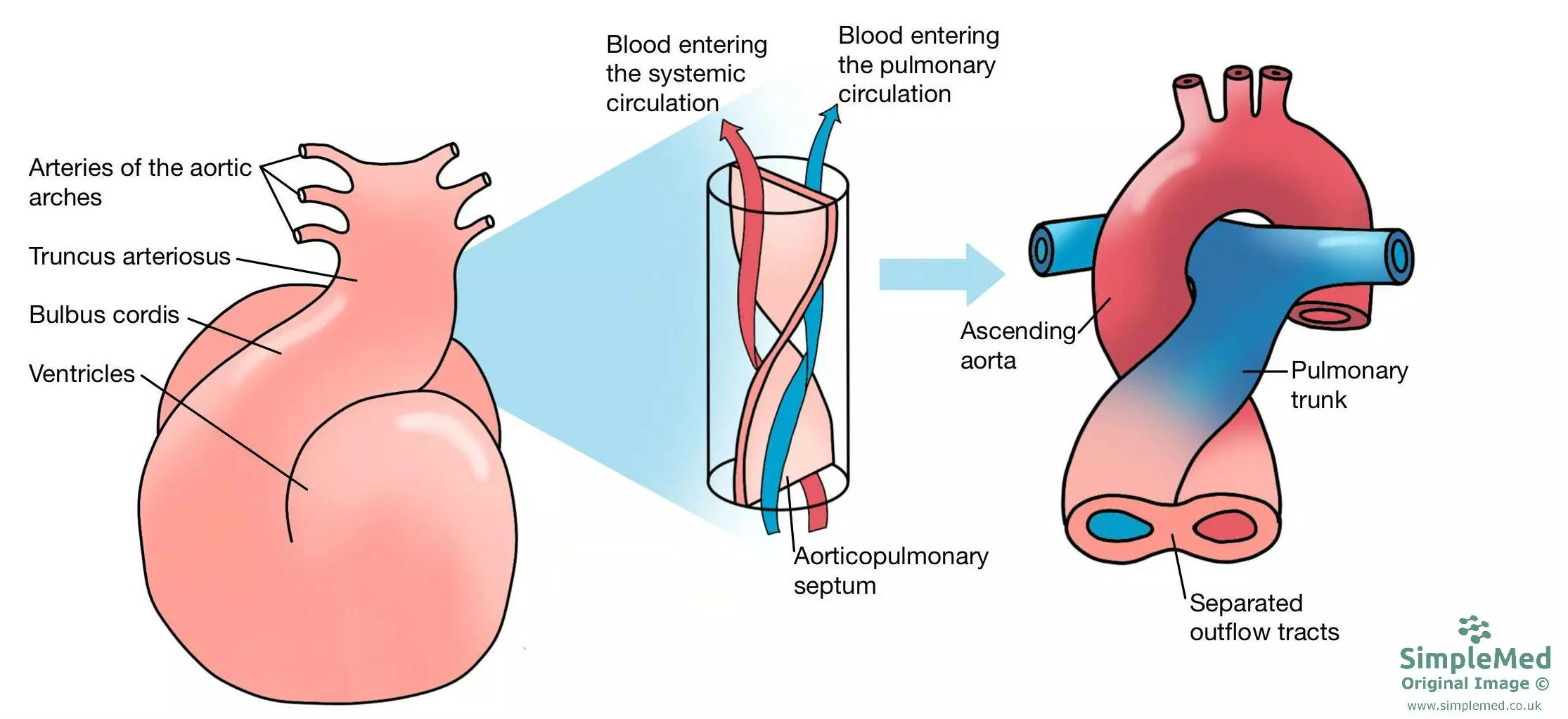
Diagram - The formation of the aorticopulmonary septum. It shows the development of the pulmonary artery and the arch of the aorta with its branching vessels
SimpleMed original by Bethany Turner
Formation of the Great Vessels
Vessels arise from the truncus arteriosus as aortic arches. There are five pairs of arches, numbered I, II, III, IV, VI (arch V doesn’t form in humans, so there are 5 arches numbered between 1-6 without a number 5). These arches, along with the trucncus arteriosus, contribute to the formation of large arteries:
- Truncus arteriosus: divided by the aorticopulmonary septum to form the pulmonary trunk and the aorta.
- Sixth arch: goes on to form the right and left pulmonary arteries arising from the pulmonary trunk. The left artery maintains its connection to the rest of the vessels via the ductus arteriosus, however the right artery loses this connection. When the baby is born and the ductus arteriosus closes, this separates the pulmonary circulation from the systemic circulation.
- The sixth arch is also known as the pulmonary arch.
- Fourth arch: on the left side becomes the arch of the aorta, and on the right becomes the right subclavian.
- Third arch: becomes the common carotids and the first part of the internal carotids.
- Second and first arches: disappear.
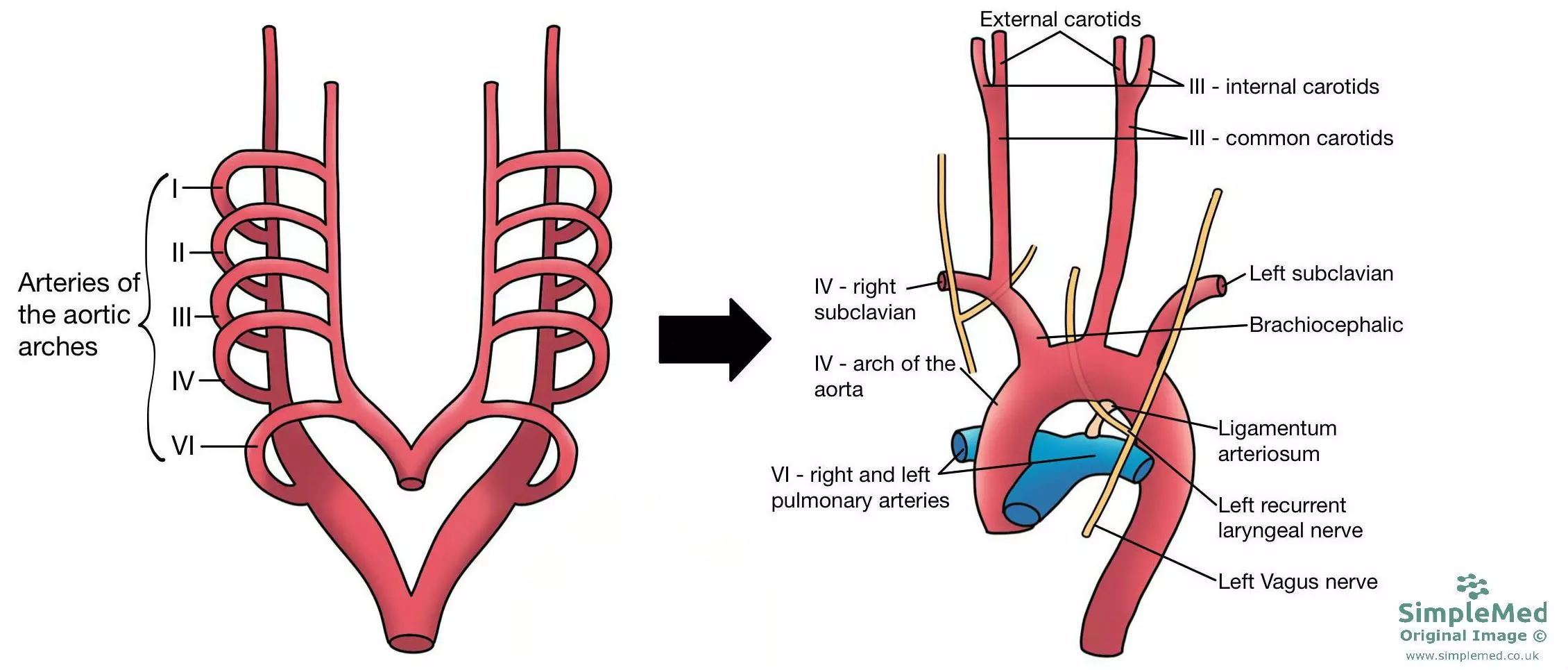
Diagram - Shows the development of the vessels from aortic arches, to the final arrangement of the vessels. Also shows the final position of the right and left vagus nerves and recurrent laryngeal nerves. The left recurrent laryngeal nerve loops under the arch of the aorta while the right recurrent laryngeal nerve loops under the right subclavian artery
SimpleMed original by Bethany Turner
The fetal circulation works very differently to adult circulation. The following steps outline the flow of blood from the placenta to the systemic circulation of the fetus:
- Oxygenated blood is carried from the placenta into the fetal circulation via the umbilical vein.
- The oxygenated blood enters the inferior vena cava and mixes with deoxygenated blood. It bypasses the developing liver via the ductus venosus.
- The liver is very metabolically active, so bypassing it means that oxygenated blood can maintain its oxygen saturation for when it reaches the heart to be pumped around the body (most importantly, the brain)
- The blood enters the right atrium and passes into the left atrium via the foramen ovale, therefore bypassing the pulmonary circulation. The blood is able to shunt from the right to left side of the heart because pressure in the right side of the heart is higher than the left in the fetus.
- The baby is not breathing and instead the fetus' blood is being oxygenated by the mother's blood. Therefore blood doesn’t have to go to the alveoli for oxygenation, so the pulmonary circulation can be bypassed.
- The blood is pumped from the left ventricle into the aorta.
- Blood that doesn’t pass through the foramen ovale, and instead is pumped into the pulmonary trunk from the right ventricle, enters the systemic circulation at the arch of the aorta via the ductus arteriosus. This system exists so that the right ventricle still has some blood to pump against. In the developing heart, the rule of 'use it or lose it' applies, so if the right ventricle has no blood passing though it, it will be underdeveloped in the mature heart. This is relevant in congenital heart defects such as tricuspid atresia.
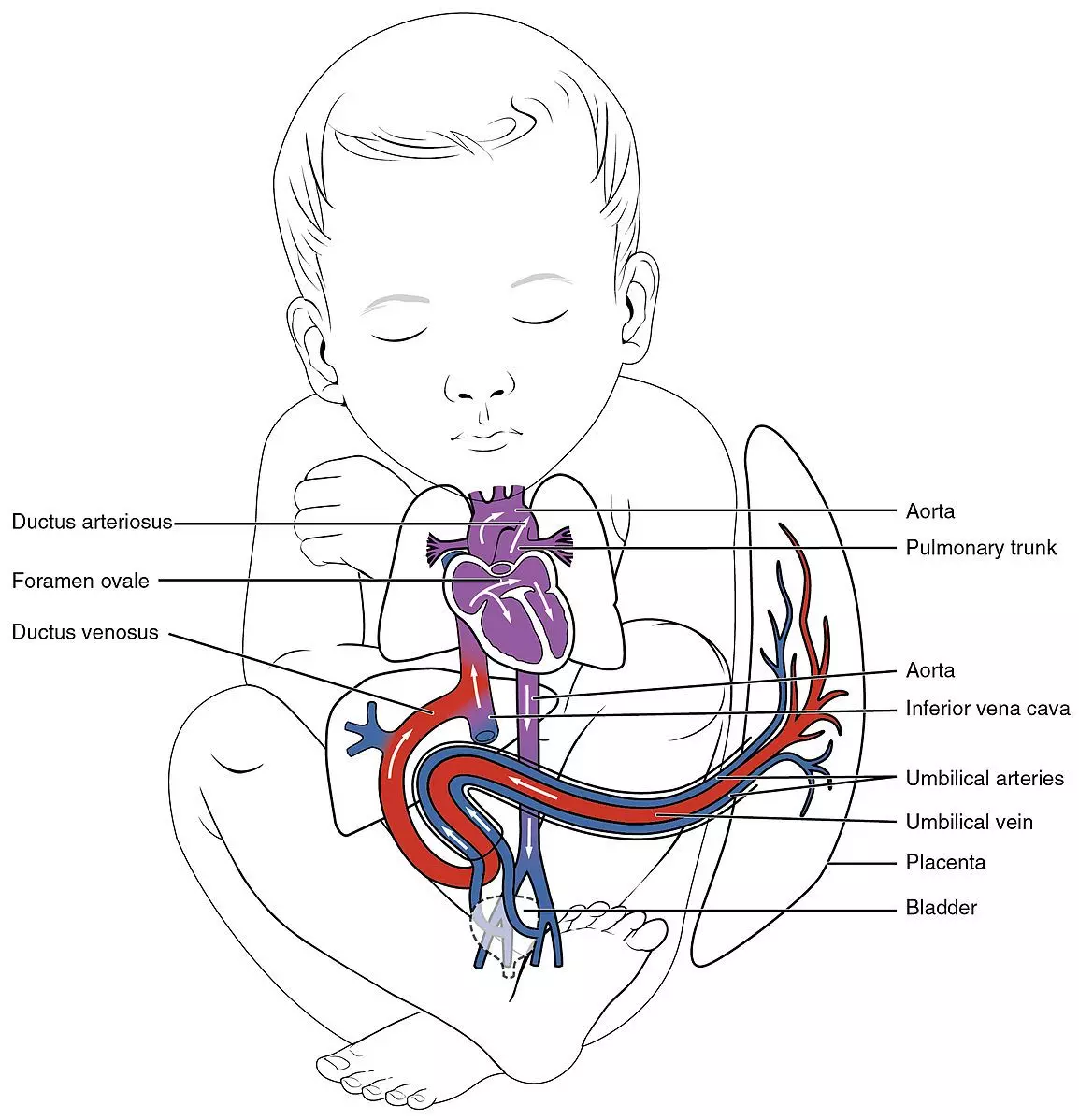
Diagram - The fetal circulation. Blood comes in through the umbilical vein, around the fetal body, and back to the placenta via the two umbilical arteries
Creative commons source by OpenStax college [CC BY-SA 4.0 (https://creativecommons.org/licenses/by-sa/4.0)]
Changes to the Circulation After Birth
- When the baby takes its first breath, the pO2 increases. This change causes the ductus arteriosus to close.
- Ductus arteriosus becomes the ligamentum arteriosum.
- More blood now flows through the pulmonary circulation as blood in the pulmonary trunk cannot leave via the ductus arteriosus anymore. This causes increased venous return to the left atrium, leading to an increase in left atrial pressure. The pressure in the left atrium exceeds that of the right, which causes the foramen ovale to close.
- Foramen ovale becomes the fossa ovalis.
- When the umbilical cord is cut, there is no longer blood flowing through the umbilical vein, causing the ductus venosus to collapse.
- Ductus venosus becomes the ligamentum teres.
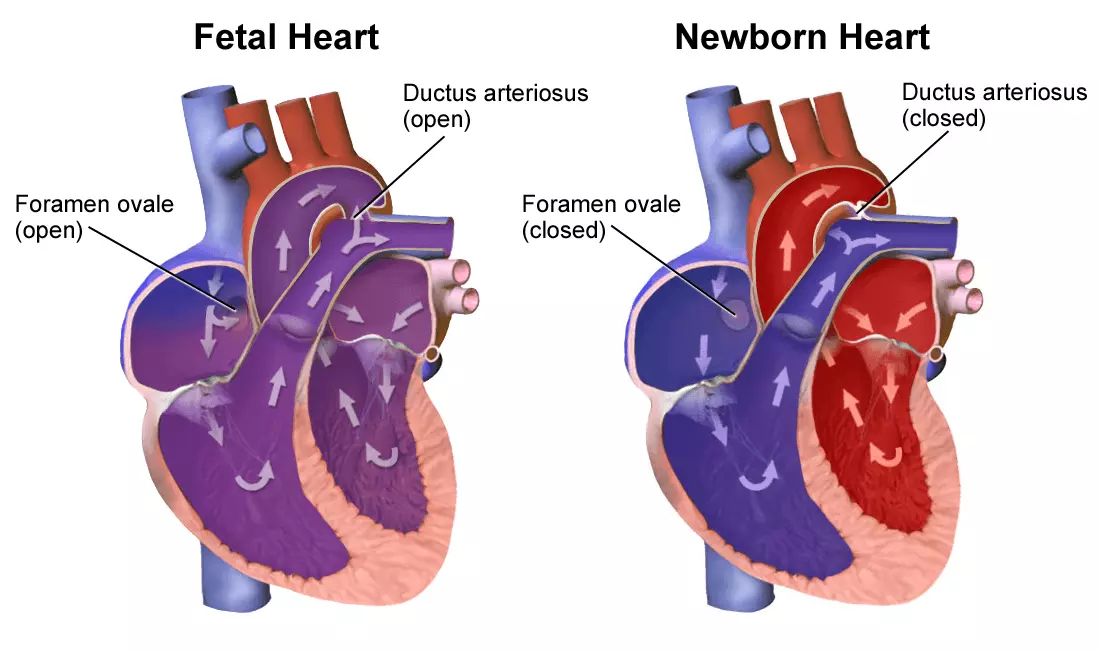
Diagram - The changes that have occurred after the baby has been born. The changes shown are the ligamentum arteriosum (closed ductus arteriosus) and fossa ovalis (closed foramen ovale)
Creative commons source by BruceBlaus [CC BY-SA 4.0 (https://creativecommons.org/licenses/by-sa/4.0)]
Edited by: Dr. Ben Appleby
- 42535

